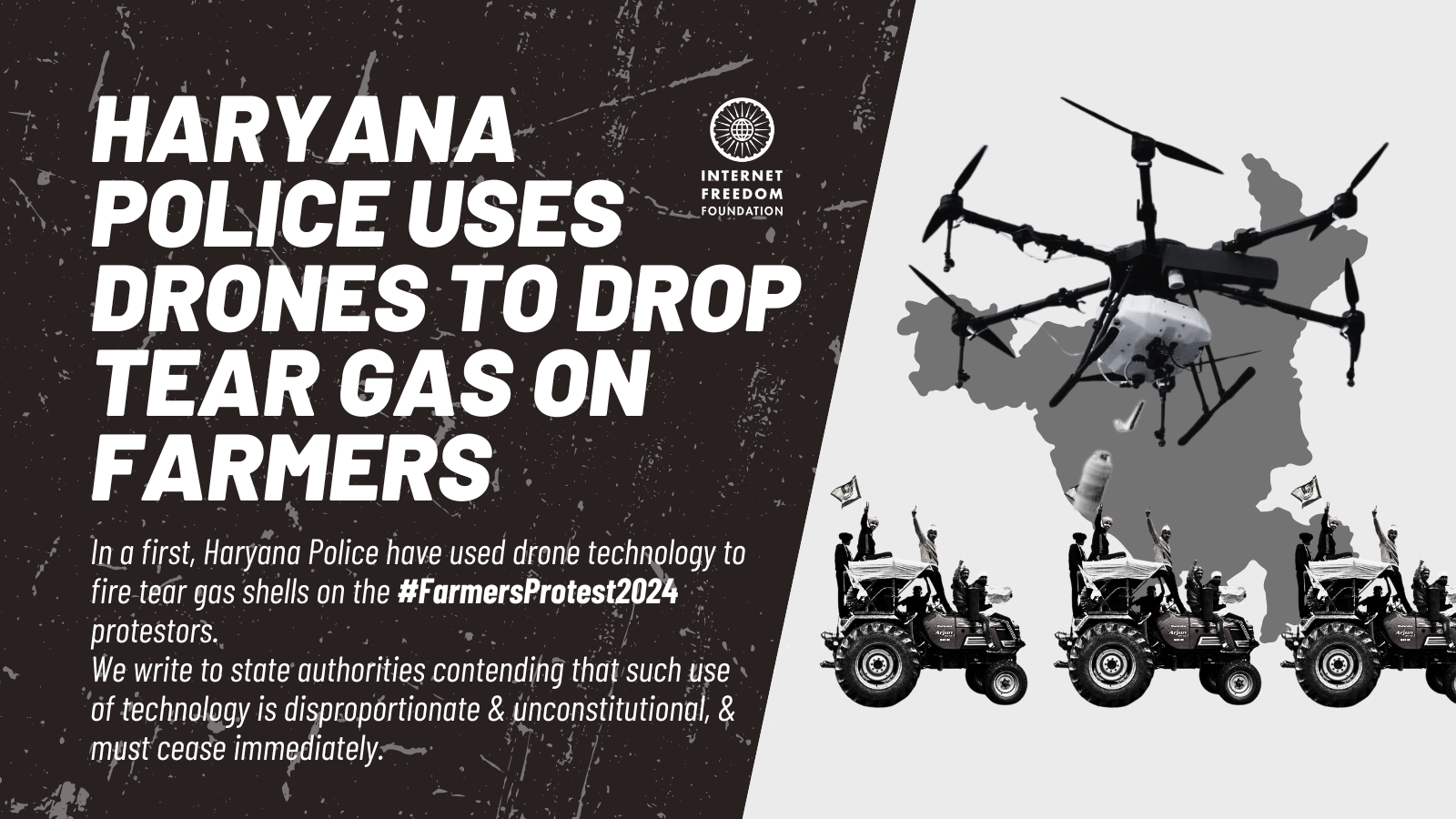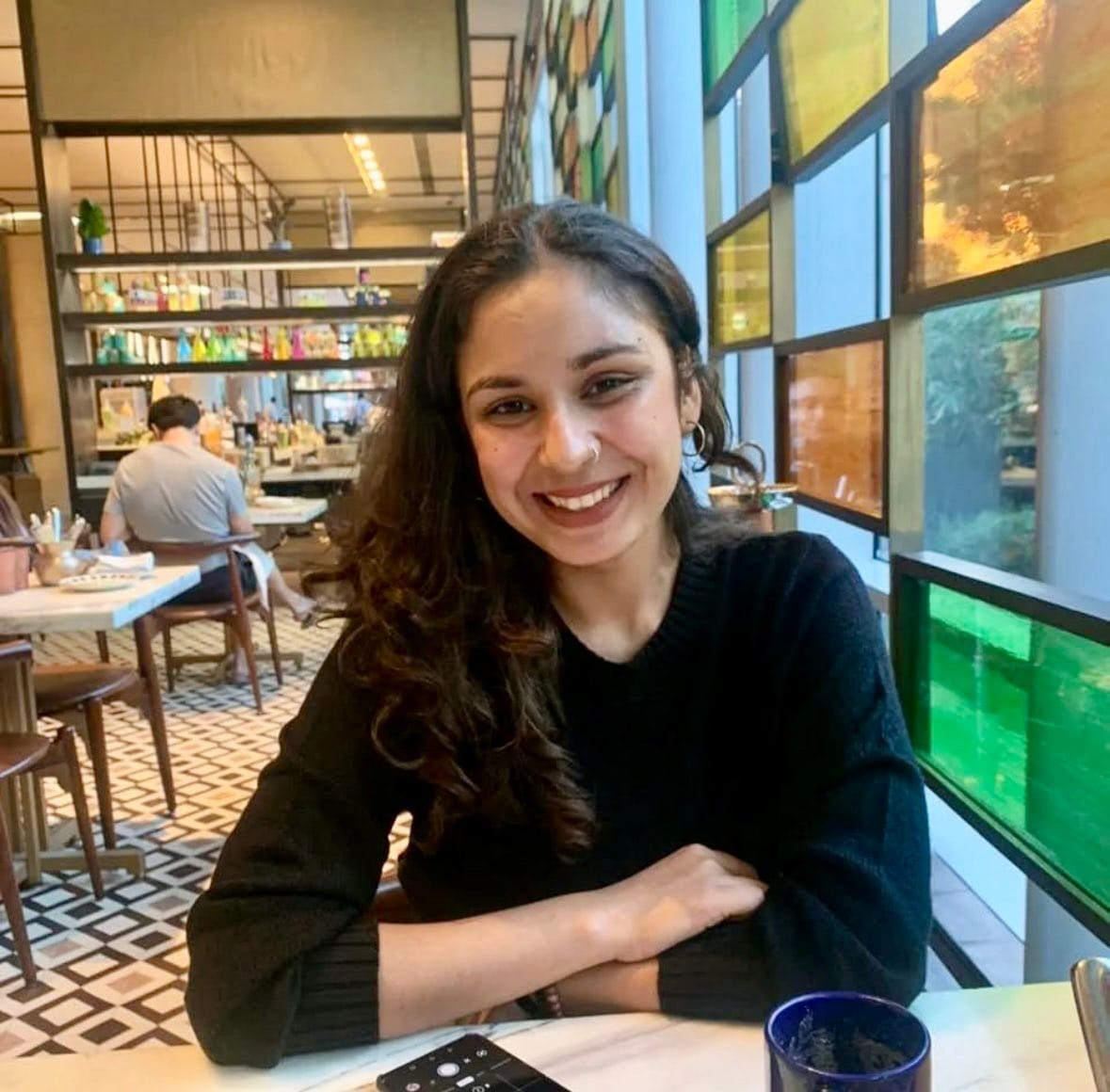
tl;dr
Haryana police is deploying drones to drop tear gas shells on farmers protesting near Shambhu border, violating several of their fundamental rights and compromising their health, privacy, and life. Though there is no transparency about their use or whether the drones possess surveillance technologies, privacy concerns are not far-fetched because drones used to stifle protests globally usually do. The past year has seen a worrying spike in demand for drones by Indian law enforcement agencies for policing, surveillance, and security – all in the absence of a law to regulate use of drones by the police. We wrote to the Haryana Home Department flagging our concerns and demanding that such usage be stopped immediately.
Background
The Farmers’ Protests
Farmers’ protests against an unfavourable policy regime began three years ago with the introduction of the 2021 Farmers’ Produce Trade and Commerce (Promotion and Facilitation) Act, Farmers’ (Empowerment and Protection) Agreement of Price Assurance and Farm Services Act, and Essential Commodities (Amendment) Act passed by the union which, among other arbitrary provisions, prescribe a detrimental Minimum Support Price (“MSP”) for farmers. Though the laws were officially scrapped by the union noting dismay from the agricultural sector, farmers were left with no clear legal guarantees of an MSP, which acts as a safety net for the farming community.
Now, ahead of the 2024 Lok Sabha elections, farmers from several Indian states have resumed their demonstrations by deciding to walk to New Delhi, seeking legal guarantees of a MSP, waivers of farm loans, and a rollback of all policies that impede farmer welfare. Their Delhi Chalo march began on February 13, 2024, and was met with overwhelming blockades from police forces, with over 50,000 security personnel deployed at Delhi’s borders. Delhi police imposed Section 144 of the Criminal Procedure Code at the Uttar Pradesh borders, and the Haryana government suspended internet services and bulk SMS in seven districts – Ambala, Kurukshetra, Kaithal, Jind, Hisar, Fatehabad and Sirsa.
Read our statement on the rampant internet shutdowns and online censorship in response to farmers’ protest to know more.
A disproportionate response
But the disproportionate police response took a dangerous form when, to stifle the protests, Haryana police began deploying unmanned aerial vehicles (“UAV”s) such as drones to drop tear gas shells on farmers near the Shambhu border. This marks the first time that any Indian police force has used drones to silence protesters in this manner.
We have concerns about the Haryana police using technology to stifle and harm protesters, and believe that such use of drones directly violates the protester’s fundamental rights to free speech, free movement, health, privacy, dignity, and ultimately, life. As the Delhi Chalo march resumed after a two-day halt on Wednesday, February 21, 2024, we wrote to the Haryana Home Department strongly urging them to cease the use of drones to fire tear gas on tens of thousands of protesting farmers.
Our concerns
In our letter to the Home Department, we noted that the manner in which Haryana police is using drones during the protests is unregulated and not backed by proper legal procedure, is disproportionate in nature, and unconstitutional to the extent that it violates the fundamental right of citizens to protest and other constitutional guarantees.
No law to regulate police use of drones
Presently, UAVs including drones, are being used by law enforcement agencies in the absence of an adequate legal framework to prohibit their misuse or arbitrary deployment. Drone Rules, 2021 (“Rules”) prescribed under the Aircraft Act, 1934 by the Ministry of Civil Aviation currently regulate UAVs in India. However, the Rules merely create a licensing regime with the objective of regulating private entities that wish to operate UAVs in specified flying zones for research and development purposes. It does not govern or prescribe any standards or limitations for their use by government agencies.
This is worrying because the past year has seen a spike in demand for drones by Indian law enforcement agencies for policing, surveillance, security, or maintaining law and order. The agencies, which largely constitute state police forces, are using drones without clear guidelines or standard operating procedures to regulate or limit their powers within the Constitutional framework. Further, there is no transparency on the personal and non-personal data these law enforcement agencies collect through drones, how they use or process it, who they share it with, and so on.
Unreasonable restriction to the right to protest
Indian citizens have the fundamental right to protest, drawing from the right to freedom of free speech and expression i.e. Article 19(1)(a) and freedom of peaceful assembly i.e. Article 19(1)(b) of the Indian Constitution. In Maneka Gandhi v. Union of India [AIR 1978 SC 597], a seven-judge bench of the Supreme Court noted that fundamental rights and freedoms are not absolute and can be limited by reasonable restrictions – but such restrictions must be necessary, proportionate, and follow procedure established by law.
Without such clear and adequate legal safeguards or procedures that put necessary limitations on executive power, the use of drones by the police to infringe upon this fundamental right in India remains arbitrary and potentially unconstitutional.
A threat to the fundamental right to health and life
Using drones to fire tear gas shells at protesting farmers directly violates their fundamental right to life under Article 21 of the Constitution. The Haryana police has fired over a thousand tear gas shells from drones in at least three instances – on February 13, 14 and 21, 2024 – over tens of thousands of protesters (see reports here, here and here). Some shells were reportedly dropped in the midst of a temporary ceasefire between the protesters and the Haryana police. Those present at the border overnight further believe that drones may have been used to drop tear gas shells on the farmers as they slept.
Globally, experts have raised alarms and voiced grave concerns over the use of tear gas by law enforcement agencies to quell protests (see the resource Tear Gas: An Investigation collated by Amnesty International). Prolonged exposure to tear gas can pose severe health risks, violating the protesters’ right to health – an essential component of the fundamental right to life.
Potential surveillance and privacy concerns
Concerns around protest surveillance also emerge. It is not confirmed from news reports whether the drones used by Haryana police also possess facial detection or recognition technologies. We do not have any transparency on the make and model of these drones, the kind of equipment used, or how reportedly police officials are able to use them to “check movement on the left and right side of the bridges and drop shells accordingly.”
The lack of information is a cause for concern because globally, drones used by law enforcement agencies to stifle protests usually come equipped with cameras, microphones, speakers, or communications interception tools. Surveillance of protesters and collection of data about their faces, location or movement can severely jeopardise their fundamental rights to privacy and to freedom of speech and movement, as enshrined in Articles 21, 19(1)(e) and 19(1)(d) of the Constitution respectively.
Our demand
We strongly urge the Haryana police to cease the use of drones to fire tear gas on protesting farmers. Law enforcement agencies must take proportionate and constitutional approaches in the interest of maintaining public order, without compromising the safety and well-being of the protesting farmers.

